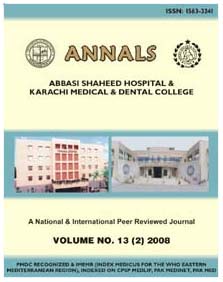
| |
| Home |
| Editorial Staff |
| Instruction to Authors |
| Journal-Issues |
| Policy |
| Copyright |
| DENTAL CARIES AMONGST PRESCHOOL CHILDREN
IN MANGHOPIR, KARACHI, PAKISTAN
1 ABDUL ALEEM, 2 M. ASHRAF AYUB, 3 REHAN QURESHI, 4 SANA ALEEM ABSTRACT Aim: To determine prevalence, severity, and pattern of dental caries in preschool children of Manghopir, Karachi, Pakistan. Materials and Methods: From the area of Manghopir, Karachi a total of 789 randomly selected preschool children, 379 (48%) male and 410 (52%) female, with mean age of 4.7 (SD 0.8) years were examined for dental caries using World Health Organization (WHO) diagnostic criteria. Results: The overall caries prevalence among the sample was 62.1%. The mean decayed, missing, and filled (dmft) score was 3.2 (SD 1.9) with a decay component of 2.4, a missing component of 0.3, and a filled component of 0.5. There was no significant difference (p>.05) in caries prevalence and severity in relation to gender of the children. However, the caries prevalence and severity were significantly higher (p<.05) among children from government preschools as compared to those from private preschools. Among the posterior teeth, mandibular second molars (54.3%), and among anterior teeth, maxillary central incisors (27.9%) had the highest caries prevalence. Among the molars, caries prevalence was generally high in lower molars while among the anterior teeth, upper teeth generally had a higher caries prevalence. The majority of the children (58.4%) had posterior tooth caries only, 34.2% had both posterior and anterior tooth caries, while very few (7.3%) children had only anterior tooth caries. Conclusion: Caries prevalence and severity were high in the study population, and most children had posterior tooth caries. Keywords: Caries, prevalence, preschool children, DMFT.
|
For Full text contact to:
|
|
1 Demonstrator, Community Dentistry, KMDC.
|

Copyright © 2009 Abbbas Shaheed Hospital and Karachi Medical & Dental College.
All rights reserved.
Designed & Developed by: Creative Designers